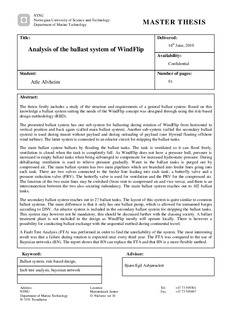| dc.contributor.author | Alvheim, Atle | nb_NO |
| dc.date.accessioned | 2014-12-19T12:05:31Z | |
| dc.date.available | 2014-12-19T12:05:31Z | |
| dc.date.created | 2010-11-22 | nb_NO |
| dc.date.issued | 2010 | nb_NO |
| dc.identifier | 371740 | nb_NO |
| dc.identifier.uri | http://hdl.handle.net/11250/237712 | |
| dc.description.abstract | The thesis firstly includes a study of the structure and requirements of a general ballast system. Based on this knowledge a ballast system suiting the needs of the WindFlip concept was designed through using the risk-based design methodology (RBD).
The presented ballast system has one sub-system for ballasting during rotation of WindFlip from horizontal to vertical position and back again (called main ballast system). Another sub-system (called the secondary ballast system) is used during transit without payload and during onloading of payload (one Hywind floating offshore wind turbine). The latter system is connected to an eductor circuit for stripping the ballast tanks.
The main ballast system ballasts by flooding the ballast tanks. The tank is ventilated so it can flood freely, ventilation is closed when the tank is completely full. As WindFlip does not have a pressure hull, pressure is increased in empty ballast tanks when being submerged to compensate for increased hydrostatic pressure. During deballasting ventilation is used to relieve pressure gradually. Water in the ballast tanks is purged out by compressed air. The main ballast system has two main pipelines which are branched into feeder lines going into each tank. There are two valves connected to the feeder line leading into each tank; a butterfly valve and a pressure reduction valve (PRV). The butterfly valve is used for ventilation and the PRV for the compressed air. The function of the two main lines may be switched (from vent to compressed air and vice versa), and there is an interconnection between the two also securing redundancy. The main ballast system reaches out to 102 ballast tanks.
The secondary ballast system reaches out to 27 ballast tanks. The layout of this system is quite similar to common ballast systems. The main difference is that it only has one ballast pump, which is allowed for unmanned barges according to DNV. An eductor system is included in the secondary ballast system for stripping the ballast tanks. This system may however not be mandatory, this should be discussed further with the classing society. A ballast treatment plant is not included in the design as WindFlip mostly will operate locally. There is however a possibility for conducting ballast exchange with the sequential method during continental travel.
A Fault Tree Analysis (FTA) was performed in order to find the unreliability of the system. The most interesting result was that a failure during rotation is expected once every third year. The FTA was compared to the use of Bayesian networks (BN). The report shows that BN can replace the FTA and that BN is a more flexible method. | nb_NO |
| dc.language | eng | nb_NO |
| dc.publisher | Norges teknisk-naturvitenskapelige universitet, Fakultet for ingeniørvitenskap og teknologi, Institutt for marin teknikk | nb_NO |
| dc.title | Analysis of the ballast system of WindFlip | nb_NO |
| dc.type | Master thesis | nb_NO |
| dc.contributor.department | Norges teknisk-naturvitenskapelige universitet, Fakultet for ingeniørvitenskap og teknologi, Institutt for marin teknikk | nb_NO |
